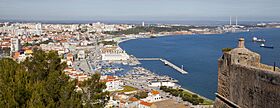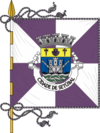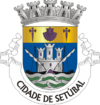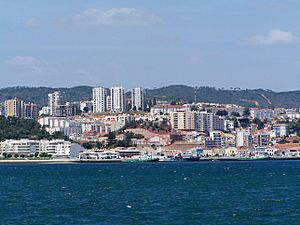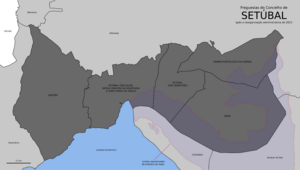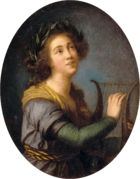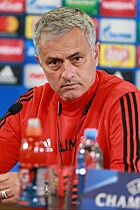Setúbal facts for kids
Quick facts for kids
Setúbal
|
|||
|---|---|---|---|
|
Municipality
|
|||
|
Clockwise: View of Setúbal from Castelo de São Filipe; Bocage Gardens; Santa Maria da Arrábida Fort; Praça do Bocage; São Julião Church; view of Setúbal from the Sado Estuary.
|
|||
|
|||
 |
|||
| Country | |||
| Region | Lisboa | ||
| Metropolitan area | Lisbon | ||
| District | Setúbal | ||
| Parishes | 5 | ||
| Area | |||
| • Total | 230.33 km2 (88.93 sq mi) | ||
| Population
(2014)
|
|||
| • Total | 118,166 | ||
| • Density | 513.029/km2 (1,328.74/sq mi) | ||
| Time zone | WET/WEST (UTC+0/+1) | ||
| Local holiday | 15 September | ||
Setúbal is a beautiful city and a municipality in Portugal. It's located about 50 kilometers (31 miles) south of Lisbon, Portugal's capital. In 2014, about 118,166 people lived in the whole municipality. The city itself had 89,303 residents in 2001.
Long ago, during the time of Al-Andalus, the city was called Shaṭūbar. This name came from an even older name, Cetobriga. In the 1800s, English speakers called its port Saint Ubes.
Setúbal celebrates its municipal holiday on September 15th. This date is special because in 1860, King Pedro V officially recognized Setúbal as a city!
Contents
Discovering Setúbal: A Coastal City
Setúbal sits on the northern side of the Sado River estuary. An estuary is where a river meets the sea. This city is also the main city of the Setúbal District.
Years ago, in the early 1900s, Setúbal was a very important place for fishing in Portugal. It was especially known for processing and sending out sardines. While those old factories are gone, the city still has strong ties to the ocean. Its ports are busy with traditional boats, cargo ships, and new marinas for pleasure boats.
Today, tourism is a big part of Setúbal's life. People love to visit because of its amazing natural beauty. The city has great hotels and resorts. It's connected to both the Sado (river) and the Atlantic Ocean.
Nature and Beaches in Setúbal
Setúbal is close to the Arrábida hills natural park. This park has untouched nature and lovely beaches along the Atlantic Ocean. A special group of dolphins lives in the Sado River estuary!
Across the river, you can see the Tróia peninsula. This area has long, white-gold sand beaches. Many fancy hotels and resorts have been built there recently. Some of Setúbal's beautiful beaches include Albarquel, Figueirinha, Galápos, Galapinhos, Creiro, and Portinho da Arrábida. These are located on the north side of the estuary, near the Arrábida hills.
Setúbal's Rich History
In ancient times, Setúbal was known as Cetobriga. It was a settlement of the Turdetani people. Later, it became part of the Roman province called Lusitania.
Culture and Landmarks
One of Setúbal's most important historical buildings is the Monastery of Jesus of Setúbal. This church was built in the 1400s and 1500s. It's one of the first examples of a special Portuguese building style called Manueline.
The city is also home to the Roman Catholic Diocese of Setúbal. The main church for the bishop is the Our Lady of Grace Cathedral, Setúbal. It's known for its unique Mannerist style front.
You might also want to see the São Julião Church. It also has beautiful Manueline doorways. The Castelo de São Filipe is a fortress from the 1500s and 1600s. It sits on the north bank of the Sado river and looks over the city. This old fortress has even been turned into a fancy hotel called a pousada.
Setúbal also has its own theater group, Teatro Animação de Setúbal.
Population of Setúbal
The number of people living in Setúbal has grown a lot over the years.
| 1801 | 1849 | 1900 | 1930 | 1960 | 1981 | 1991 | 2001 | 2011 | 2014 |
|---|---|---|---|---|---|---|---|---|---|
| 15,442 | 15,060 | 35,990 | 50,456 | 56,344 | 98,366 | 103,634 | 113,934 | 121,061 | 118,428 |
Local Areas: Civil Parishes
For administrative reasons, the municipality of Setúbal is divided into five smaller areas called civil parishes (freguesias):
- Azeitão (São Lourenço e São Simão)
- Gâmbia – Pontes – Alto da Guerra
- Sado
- São Julião, Nossa Senhora da Anunciada e Santa Maria da Graça
- São Sebastião
Setúbal's Climate
Setúbal has a Mediterranean climate. This means it has mild, rainy winters and warm to hot, dry summers.
- In winter, daytime temperatures are usually between 15 and 17 degrees Celsius (59-63°F). Nights are cooler, from 5 to 8 degrees Celsius (41-46°F). Most of the rain falls in this season, starting in November.
- In summer, days are warm, between 27 and 30 degrees Celsius (81-86°F). Nights are around 15 to 17 degrees Celsius (59-63°F). There is very little rain during summer.
The average temperature for the whole year is about 16.5 to 17 degrees Celsius (62-63°F).
On August 4, 2018, Setúbal had a record high temperature of 45.5 degrees Celsius (113.9°F). This was the highest temperature ever recorded on the coast of the Iberian Peninsula!
Economy and Jobs
In 2011, Setúbal had about 58,514 people working. Most people (73.5%) worked in the service industry, like shops, hotels, and offices. About 24.9% worked in manufacturing, and a small number (1.6%) worked in farming or fishing.
Setúbal is known for several industries, including:
- Making pulp and paper.
- Producing cement and fertilizers.
- Building and repairing ships.
- Generating thermal power.
- In the past, many car companies had assembly plants here. Today, a few car brands still produce vehicles nearby.
The Port of Setúbal is also very important. In 2012, it handled over 6 million tons of cargo. This made it the 4th busiest port in Portugal. In the 1800s, the area was famous for making sea salt, which was even sent as far as Australia!
Getting Around Setúbal
Setúbal has a train station called Praça do Quebedo station. You can catch trains to Lisbon every hour on weekdays, or every half-hour during busy times. From Lisbon, you can connect to other cities in Portugal. There are also trains south to Faro and east to Ebora.
The city also has local buses and a network of roads to help people travel around.
Sports in Setúbal
The main sports club in Setúbal is Vitória de Setúbal. This football (soccer) club was started on November 20, 1910.
Famous People from Setúbal
Setúbal has been home to many interesting people, from explorers to artists and sports stars!
Public Service
- Diogo Fernandes Pereira (born around 1400s) was an explorer who visited the island of Socotra in 1503. He also discovered the Mascarenes islands in 1507.
- José Travassos Valdez, 1st Count of Bonfim (1787–1862) was a soldier and politician who became Prime Minister of Portugal.
- Rui Machete (born 1940) is a Portuguese politician and government minister.
Arts and Culture
- Manuel Maria Barbosa du Bocage (1765–1805) was a famous poet known for his satirical and classical poems.
- Luisa Todi (1753–1833) was a talented Portuguese opera singer.
- João Vaz (1859-1931) was a painter known for his beautiful sea scenes.
- Zeca Afonso (1929-1987) was a well-known singer and songwriter who lived and worked in Setúbal.
- Manuela Couto (born 1964) is a Portuguese actress who has worked in TV, movies, and theater.
- Luís Buchinho (born 1969) is a Portuguese fashion designer.
- Sabrina (born 1982) represented Portugal in the Eurovision Song Contest 2007.
Sports
- Jaime Graça (1942–2012) was a footballer and coach who played many games for clubs and for the Portuguese national team.
- Silvino Louro (born 1959) was a goalkeeper who also played many games for clubs and for the Portuguese national team.
- José Mourinho (born 1963) is a very famous football manager.
- Bruno Lage (born 1976) is a football manager, known for coaching teams like Wolverhampton Wanderers F.C..
- Susana Costa (born 1984) is a Portuguese athlete who specializes in the triple jump.
Setúbal's International Friends
Setúbal has special connections with other cities around the world. These are called "twin towns" or "sister cities." They work together on cultural and other projects.
Setúbal also has cooperation agreements with:
|
Images for kids
See also
 In Spanish: Setúbal para niños
In Spanish: Setúbal para niños


